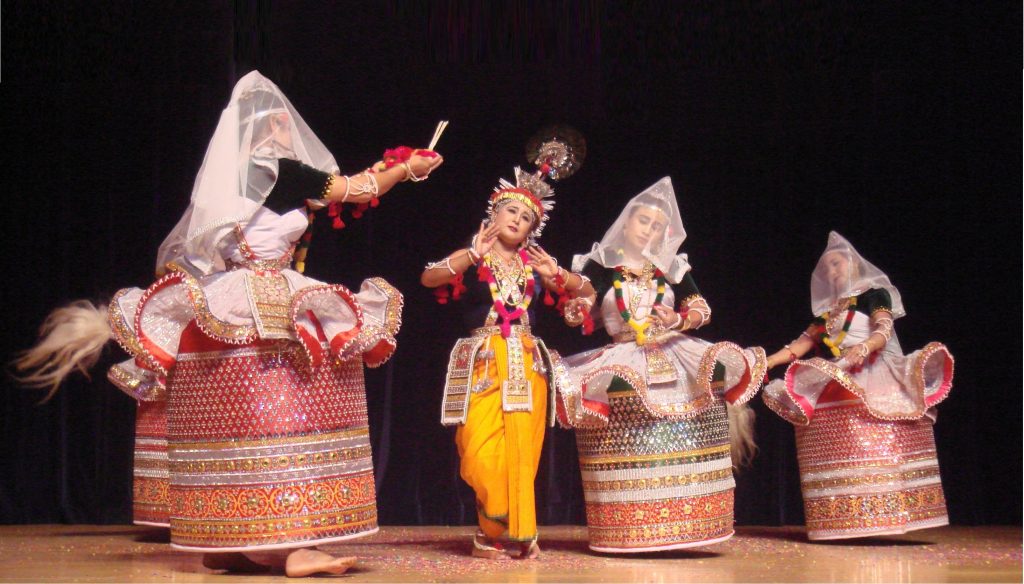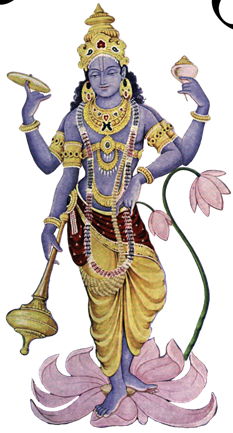Entertainment
Dance, drama, science, technology, art, music, architecture, cuisine, and literature are parts of most cultures. These all provide entertainment to the followers of the Gita.
4 minute read

There are three broad categories of entertainment: that which elevates, that which furthers worldly attachment, and that which degrades. The first one involves the names and lilas, or stories, of Vishnu and Krishna. (See the section on enjoyment for a discussion of lilas.)
The elevating type of entertainment is based on reducing selfishness and greed. Thus, it has a direct impact on the environment. In this type of entertainment, most of the excesses of modern media are absent.
The topic of entertainment within the Vaishnava culture is vast. What follows is just an outline of some of the categories and types of enjoyment available.
Dance
There are various regional dance forms that have been practiced for hundreds and in some cases thousands of years. These styles are used to depict Vishnu’s, or more often, Krishna’s lilas.
The following nine are the best known: Bharatanatyam, Kathak, Kuchipudi, Odissi, Kathakali, Sattriya, Manipuri, Mohiniyattam, and Bhagavata Mela.
Some add the Chhau and Yakshagana dance styles to these.
Drama
Since ancient times dramas have been popular. Like Greek plays, they were often in verse. The best dramas were performed for royalty and upper classes whereas there were traveling troupes, called yatras, that catered to the villagers.
Some of these dramas were directly based on the lilas mentioned in the Puranas. Some were extensions or poetic interpretations of the lilas. And some merely had reference to the lilas.
Despite the dominant movie industry in Bollywood, these plays are still popular, especially in the places of pilgrimage.
In Southeast Asian countries that have been heavily influenced by Vaishnava culture, there are still dances, puppet shows, storytelling, and dramas based on the lilas.
In the early 20th century, when movies were first produced in India, most of the them were about lilas and the lives of the saints, which are themselves sometimes considered lilas of sorts.
Science
In the last two-hundred years, science has evolved narrowly, perhaps because of its close connection with technology, which has captivated and intoxicated humanity.
In the past, science involved not only study of physical phenomena, but also the metaphysical and most importantly, the responsibilities of the individual, society, and humanity. Without such a practical branch of science, it renders practically the whole of modern science not just amoral, but also irresponsible.
Vaishnava science includes cosmology, psychology, astronomy/astrology, sociology, history, political science, medicine, botany, zoology, as well as other branches.
Vaishnava science has been traditionally based primarily on Samkhya, Vedanta, and yoga philosophy. There are many interpretations of these three, but Vaishnavas generally rely on the Upanishads, Bhagavad Gita, and the puranas, especially, the Bhagavat Purana, for clarity.
Art
There are many, many examples of traditional Vaishnava art. As with many other cultural forms, Vaishnava art has influenced and been influenced by many outside styles. A recent example is Mughal art, enjoyed by the Mughal emperors ruling from the sixteenth to eighteenth centuries.
From ancient times to the present, there are ample examples of stone, metal, clay, and wood sculpture, bas relief, and wall paintings.
There are many temples with statues carved on the outside and inside, and all temples feature the main images, the various deity forms of Vishnu and His consort, Lakshmi, or Krishna and His consort, Radha.
In a few parts of India, there are temples carved out of stone caves, and they feature statuary as well.
There are examples of scrolls and paintings that were used by minstrels who traveled, sang, told stories, and used the artwork to illustrate the lilas.
Music
Traditional Vaishnava music has evolved its own styles and has also had many outside influences. Music on the Indian subcontinent can be traced back many thousands of years. The technical aspects involve microtones, notes, ornamentations, melodies, and rhythms. These take years to learn and decades to perfect. The various schools of style have been passed down for hundreds and even thousands of years.
Some of these ancient styles are dhrupad, dhamar, and sadra.
Thus, music has been an essential part of Vaishnava cultured life as well as the entertainment of the masses. Some groups like strict Buddhists and advaita Hindus discouraged music, designating it as worldly, but Vaishnavas have always incorporated the names and lilas of Vishnu in their music, so to them, music is an integral part of spirituality.
Architecture
Vastu sastra includes principles for the design and layout for temples, houses, towns, cities, gardens, roads, waterworks, shops, and other public areas. Some scholars are of the opinion that some elements of vastu design have existed for millennia before Christ.
Depending on the support of dynasties, the styles of temples varied: Mathura, in North India, was an important ancient city that has had temples for millennia; however, in the pre-Christian era, it was ruled for some time by Greeks. In the 11th century it was sacked by Muhammad of Ghazni, who destroyed the temples. In other words, since it was an important ancient city, it was vulnerable to attack and occupation.
In the ancient period, Buddhism maintained large temples and educational institutions. However, such centralization made it vulnerable to conquest. In the 6th century, the Huns wreaked havoc and by the 12th century they had been destroyed by invaders, whereas the small widespread, “peoples” culture of the Vaishnavas remained.
Vaishnava temples and gurukulas (schools) tended to be small and located in towns and villages throughout the subcontinent, thus harder to stamp out.
In some areas of India, stone is not available, so temples are built with clay (and fired into terracotta) and wood. These structures do not last through the millennia. Also, in areas like the Ganges delta, the rivers may claim such temples.
In North India, the Hoysalas (11th-14th century) and Guptas (300-550th cent) established their unique styles. And the Dravidian (South Indian) style had an influence on various dynasties from perhaps 300BCE to the 16th century CE. South India was protected somewhat from the occasional invasions and destructions wrought on the north.
Vijayanagara architecture (1350-1550 CE) is significant in South India. Associated with Vijayanagara era was the Chola dynasty (300 BCE – 1300 CE), which had influence in Malaysia, Burma, Thailand, and Indonesia. Many Vaishnava temples were established throughout these areas.
Regional, spread to Southeast Asia. Now there are Vaishnava temples throughout the world: Bali, U.S., England, Africa, Russia, etc.
Storytelling/Minstrels
For millennia there have been wandering minstrels and storytellers. Not only were stories accompanied by music, but the bards used to carry illustrated scrolls and palm leaves to enhance their tales. These stories were about Vishnu’s lilas, and often for the benefit of the local villagers, they were enhanced with local gossip and lore.
